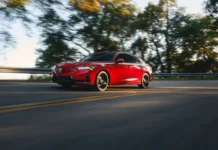
The first-generation Golf started production exactly 45 years ago today. Since its introduction, it has gone on to sell over 35 million units worldwide, making it by far Volkswagen’s best-selling model ever. To celebrate the Golf’s nearly half-decade long run, let’s take a look back at all of its iterations to see how it has evolved over the years.
Mk1 – 1975-1984

The first generation Volkswagen Golf came out as a replacement for the Beetle. And it wasn’t called the Golf, it was called the Rabbit. Though, VW continued making the Bug for a long time after 1975. When it first came out, the Golf had a small 1.5-liter four-cylinder under the hood that produced just 70 horsepower.
The Mk1 also brought us the car that would create an entire segment loved by many, the GTI. This is considered by many to be the car that created the idea of a hot hatch. It had a 1.8-liter four-cylinder with fuel injection that produced a whopping 90 horsepower. It doesn’t sound like much, but the lightweight vehicle with 20 extra horsepower turned into an icon, and started an entire segment.
Mk2 – 1985-1992

The Mk2 Volkswagen Golf is the car that actually introduced the name ‘Golf’. With this generation, the Golf saw a number of improvements, getting a bit bigger overall. The engine saw an increase in size as well, moving to a 1.8-liter four-cylinder with 85 hp. The GTI saw another power bump, introducing a 2.0-liter engine with 131 hp.
Mk3 – 1993-1999

The Mk3 saw a serious shift in design language to what Volkswagen calls the ‘Wedge’ shape. Once again, some improvements in engine options show up. The base motor is a 2.0-liter with 115 hp. However, the GTI moves to 2.8-liter VR6 with 172 hp. Though, this generation of the Golf got a bit heavy at the same time.
Mk4 – 1999-2005

The Mk4 continued the design evolution for the Volkswagen Golf family. We still had a GTI with an available VR6 narrow angle V6, but we also saw the introduction of an even higher-performing Golf variant, the R32. The R32 had a 3.2-liter VR6 engine, a manual transmission and AWD.
Mk5 – 2006-2009

In its fifth iteration, the Golf once again became the Rabbit, and saw a significant improvement in suspension design. The advent of multi-link rear suspension greatly improved handling. Plus, some new base engines brought even more power to the lineup. In the standard Rabbit, a 2.5-liter engine produced 150 horsepower. Plus, the GTI got a new 2.0-liter turbocharged four-cylinder that produced 200 horsepower. The R32 retains the VR6 engine, but only comes with a dual-clutch transmission.
Mk6 – 2010-2014

Well, we return once again to the Golf name. Plus, an updated, more aggressive design. The base 2.5-liter engine makes 170 horsepower now. Plus, the Golf R32 loses its VR6 engine, and the number 32. The Golf R now has a more aggressively tuned version of the 2.0-liter turbo from the GTI that makes 250 horsepower. Fortunately, the manual transmission returns as an option.
Mk7 – 2015-2019

Here we are today, with the latest generation Golf. The most notable improvement comes from the chassis architecture. Volkswagen moved the Golf family to the MQB platform (Modular Transverse Matrix) which significantly improved chassis stiffness, while reducing weight. The base engine becomes a 1.8-liter turbo with just as much power as the 2.5. However, it got much better gas mileage. The Golf R got more power, as did the GTI.
Mk8 – 2020-?
This leaves us with the next-generation Golf. We do not know a whole lot about the next Golf. However, we do know it will be making its arrival sometime in 2020. There will be a GTI and Golf R variant, but you will just have to stay tuned to TFLcar.com to learn more about the next-gen Golf. While you wait for more info on the next Golf, why not check out our review of the GTI’s sedan-based cousin, the new Jetta GLI:
























